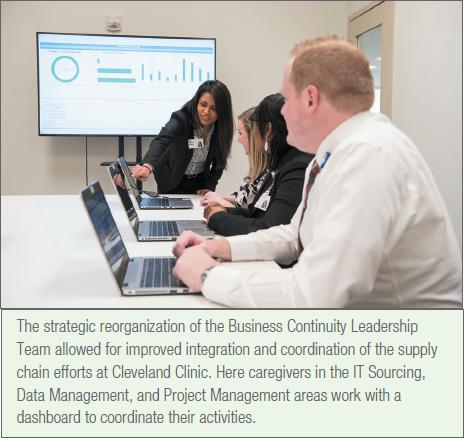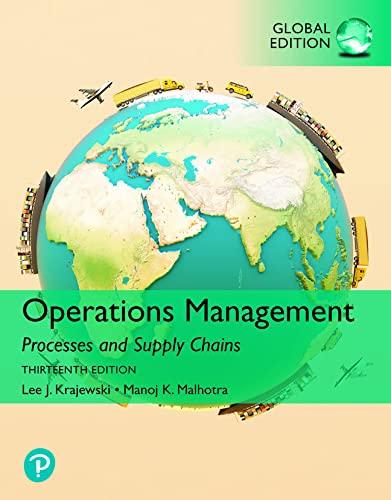Cleveland Clinic, a nonprofit multispecialty medical center based in Cleveland, Ohio, has a vast operational footprint that
Question:
Cleveland Clinic, a nonprofit multispecialty medical center based in Cleveland, Ohio, has a vast operational footprint that spans the globe. With an annual operating budget of nearly $11 billion, its mission integrates clinical and hospital care with academic and education excellence. The Clinic serves over 9.8 million patient visits (2.4 million patients) of all ages worldwide each year. With 18 hospitals--including locations in Ohio to locations in Florida, Nevada, Toronto, Abu Dhabi, and London--and more than 220 outpatient locations, the hospital system depends on skilled leadership and a global supply chain organization that is flexible, responsive, and integrated into daily operations at all locations. Prior to The Coronavirus Pandemic The current supply chain organization is highly integrated. It wasn't always so. Until recently, the various departments that supported supply chain operations had grown organically to support the ever-expanding enterprise and were organized into work silos to respond to supply chain needs within each facility. Each one had its own responsibilities, incentives, and performance metrics tied to its specific operations. For example, the purchasing silo might keep track of the number of orders placed that arrive within pre-determined response times, while the sourcing silo might have incentives centered around keeping supply costs as low as possible. That could mean that sourcing an item with a lower price from a new supplier in order to keep supply costs low, could cause a delay in procurement, thereby increasing the response time for the purchasing department. When a decision was made to replace an inventory item with a different one, departments would be told to exhaust their current supply of the old item before any new ones would be ordered. Then the new replacement item had to be integrated into all the departments using that item. The information systems in those departments had to be updated for the new item data and new labeling to occur so that the material handlers could properly track the items for replenishment. With hundreds of stocking locations spread throughout the hospitals, this was a difficult task prone to errors. Often, the incentives worked against the overall strategic goal of a "Patient First" enterprise but were so deeply entrenched that staff simply kept executing their old incentive schemes because they thought they worked to the benefit of their departments. Instead of collaborating to ensure that the best interests of the entire organization were supported, tasks and responsibilities were simply handed off without downstream impact consideration. Further compounding the silo focus, information about supplies was maintained within the silos, with little incentive to share beyond their boundaries. Existing data and information about supplies were not routinely available across operations, making the organization's information systems difficult to use for managing the supply chain. The Supply Chain Management and Patient Services Support organization consisted of the following 10 groups:
▪▪ Executive Leadership: Provides strategic planning and guidance
▪▪ Administration: Provides overall support for all teams including system support, policies, and program management
▪▪ Global Business Transformation: Cleveland Clinic has invested in an Enterprise Resource Planning software platform supporting supply chain, decision support services, corporate accounting, and IT. The purpose is to create an efficient and agile operating model for the future that scales for market growth.
▪▪ Data Analytics: Provides analytics of key metrics and maintains information in Lawson
▪▪ Business Development: Supports GPO growth, new opportunities
▪▪ Materials Management: Supports the delivery, inventorying, and couriering of products
▪▪ Purchasing: Facilitates order placement and provides transactional support
▪▪ Sourcing: Negotiates clinical and non-clinical supply contracts
▪▪ Support Services: Delivers services that support a world class experience for patients and caregivers
▪▪ Project Management Office: Oversees Mergers and Acquisitions, New Construction, and Business Development initiatives Each group was headed by a Senior Director, and essentially acted as an independent unit with its own goals and incentive agreements.
After the Advent of the Coronavirus Epidemic
The impact of COVID-19 on Cleveland Clinic's supply chain management really underscored the need to reorganize for greater efficiency, communication, materials flows, and information sharing across the enterprise; that is, integrate the internal and external supply chain. In May of 2020, Simrit Sandhu, Chief Supply Chain and Support Services Officer, and other senior supply chain managers took a bold and aggressive step to create a new cross-functional team to realign incentives and focus each supply chain group on the same metrics and service goals that are aligned with Cleveland Clinic's "Patient First" strategic initiative. This team is now called the Business Continuity Leadership Team within the Supply Chain Management Patient Support Services (SCM PSS) Organization. It combines Global Business Transformation, Data Analytics, Inventory Management Transformation, and the Project Management Office under the direction of the Chief Supply Chain and Support Services Officer.
These units will no longer be operating independently with separate goals and incentives.
To enhance the reorganization, clinical partners (physicians, dietary, patient experience managers) were invited to directly participate to ensure quality, and patient safety considerations were included instead of assumed.
This has resulted in cost savings tied to better sourcing and utilization of supplies.
The new Business Continuity integrated team now consists of 30+ staff with assignments and responsibilities that cut across operations instead of remaining in vertical silos. The new Supply Chain Organization is as follows:
▪▪ Executive Leadership: Provides strategic planning and guidance
▪▪ Administration: Provides overall support for all teams including system support, policies, and program management
▪▪ Business Continuity:
- Global Business Transformation: Manages the Enterprise Resource Planning (ERP) software platform supporting supply chain, decision support services, corporate accounting, and IT for efficient, agile, and scalable operations Project Management Office (PMO): Oversees hospital integrations, new construction, and business development initiatives
- Data Maintenance: Responsible for maintaining information integrity
Inventory Management Transformation: Supports the implementation of a system of control, used to manage supplies across the Cleveland Clinic enterprise.
▪▪ Business Development: Supports GPO growth, new opportunities
▪▪ Data Analytics: Provides analytics of key metrics and maintains information in the ERP system
▪▪ Clinical Supply Chain: End-to-end responsibility for clinical supplies including sourcing, contract negotiation, and operations supporting the delivery, inventorying, and couriering of products. Includes linen and laundry operations.
▪▪ Non-Clinical Sourcing: Negotiates non-clinical and IT supply and services contracts
▪▪ Support Services (PSS): Patient Support Services, Food Services, and Customer Support Services (including service express call center and purchasing) Now there is strategic alignment of all the work groups under the Business Continuity Leadership team. To support better information sharing, the Data Analytics group now maintains the centralized Master Item File for the entire supply chain, provides analytics of key metrics, and maintains information integrity across the work streams. The new structure supports the implementation of a system of control used to manage supplies across the Cleveland Clinic enterprise in 15 locations.
The new Business Continuity Leadership Team within the supply chain organization now has end-to-end visibility of supply and material utilization of over 192,000 individual stock-keeping units (SKUs) representing $82.4M worth of inventory. By vertically integrating into a service unit, the department is flexible and agile enough to deliver greater visibility and control over daily production and supply needs. Information flows more freely between the different enterprise areas since the silos no longer have incentives to protect their vertical interests. As a result, greater flexibility in adapting to changes in demand has improved the response capability of the Supply Chain Management and Patient Support Services Organization to support "Patient First" care and safety initiatives at the highest levels.
These changes have positively enhanced patient care. For example, during the COVID-19 outbreak in 2020, the hospital required a new type of intubation tubing that would allow a physician to insert a tube into a patient's airway at a safe distance, allowing the medical team to see what was happening with the patient's airway. The newly structured team, facing a global supply shortage, jumped into action to quickly procure the critical intubation supplies and distribute them across the organization. This was a test of the team's ability to understand the supply pipeline challenges, vendor relationships, backorder status, and coordination problems with manufacturers who could not make enough product to meet the demand. Because the newly integrated supply chain organization had reorganized its information sharing across all the former silos, improved its communications with vendors and internal departments about order status, and added information and performance metrics about new suppliers, it was much easier to keep materials flowing to the right places as needed. Such an integration across the supply chain has allowed the Supply Chain Management and Patient Support Services Organization to continue supporting Cleveland Clinic's "Patient First" strategic goal.
QUESTIONS
1. What are the key differences between the old and new supply chain organizations at Cleveland Clinic? How does the new organization promote greater integration?
2. Cleveland Clinic's goal of "Patient First" requires care that addresses every aspect of a patient's encounter with Cleveland Clinic, including the patient's physical comfort, as well as their educational, emotional, and spiritual needs. Consider the Materials Management, Purchasing, and Sourcing groups. Identify three performance measures for each one that would be consistent with the "Patient First" Goal.
3. Explain how the concept of blockchains and the Internet of Things can be useful to Cleveland Clinic with their new supply chain organization.
4. Identify three operational risks to Cleveland Clinic's supply chain and how they might be mitigated.
Step by Step Answer:

Operations Management Processes And Supply Chains
ISBN: 9781292409863
13th Global Edition
Authors: Lee Krajewski, Naresh Malhotra, Larry Ritzman





